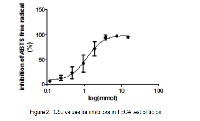GC/MS analysis, antimicrobial and Antioxidant Effect of Ethanol Garlic Extract
Keywords:
Garlic extract, Antimicrobial effect, Antioxidant Effect, feed additiveAbstract
Aim of the study: The purpose of this study was to investigate the possibility of garlic extract as a feed additive to prevent and treat Salmonella infection. Methods: Garlic extracts were prepared from fresh crushed garlic and dissolved in different concentrations of ethanol. Garlic extract (Allium sativum) was analyzed by using gas chromatography-mass spectrometry (GC-MS). To examine biological activity, the antimicrobial activity test was carried out by minimum inhibitory concentration (MIC) and minimum bactericidal concentration (MBC) against Salmonella typhimurium. Antioxidant activity of garlic extracts was examined by ABTS radical scavenging assay Results and discussion: In the GC-MS analysis, allyl trisulfide, 2-hydroxy-gamma-butyrolactone, 1, 3-dihydroxyacetne dimer, propanoic acid, 2-propone were confirmed as predominant components of garlic extract. the MIC was 10 mg/mL in all extracts. However, antioxidant effect was highest in 20 mg/mL of 100% ethanol garlic extract (82.1%). The amount of IC₅₀ (50% inhibitory concentration) was measured at 1.6 mg/mL. Conclusion: 75% ethanol garlic extract was the most efficient in considering the recovery rate, antimicrobial and antioxidant activities among the various extracts. Based on the above biological results, we could confirm this possibility as a feed additive for anti-salmonella infection.
References
NAM SM, KANG IJ, SHIN MH., Anti-diabetic and anti-oxidative activities of extracts from Crataegus pinnatifida. J. East Asian Soc. Dietary Life. 2015; 25: 270-277. 2. Jung IC, Sohn HY. Antioxidation, antimicrobial and antithrombosis activities of aged black garlic (Allium sativum). J. Microbiol. Biotechnol. 2014; 42(3): 285-292. 3. Jung M, Cha SB, Shin SW, Lee WJ, Shin MK, Yoo A, Yoo HS. The effects of Germanium biotite on the adsorptive and inhibition of growth abilities against E. coli and Salmonella spp. in vitro. Korean J Vet Res. 2012; 52(1): 33-38. 4. Saha SK, Saha S, Akhter SM, Khatun S, Islam MM, Roy P. In Vitro Determination of Minimum Inhibitory Concentration of Aqueous Garlic Extract and Imipenem against Staphylococcus aureus and Escherichia coli. Mymensingh medical journal. 2016; 25(3): 477. 5. YOON IS. Sensitivity test on the food poisoning bacteria of the garlic extract. The Journal of the Korea Contents Association. 2009; 9(2): 339-349. 6. Mochizuki E, Yamamoto T, Suzuki S, Nakazawa H. Electrophoretic identification of garlic and garlic products. J. AOAC Int. 1995; 79(6), 1466-1470. 7. Kim HJ, Han CH, Kim NY, Lee EK, Lee KN, Cho HE, Choi YH, Chong MS. Effect of garlic extracts with extraction conditions on antioxidant and anticancer activity. J Physiol & Pathol Korean Med. 2010; 24: 111-117. 8. STOLL A, SEEBECK E. Chemical investigations on alliin, the specific principle of garlic. Adv. Enzymol. Relat. Areas Mol. Biol. 2006; 11: 377-400. 9. Lee SN, Kim NS, Lee DS. Comparative study of extraction techniques for determination of garlic flavor components by gas chromatography–mass spectrometry. Anal Bioanal Chem. 2003; 377(4): 749-756. 10. Lee DG, Shin HH. Pharmacokinetics and pharmacodynamics of antibiotics: General concepts and Recent Advances. Infection and Chemotherapy. 2008; 40(3): 140-147. 11. Huang D, Ou B, Prior RL. The chemistry behind antioxidant capacity assays. J. Agric. Food. Chem. 2005; 53(6): 1841-1856. 12. Dudonné S, Vitrac X, Coutiere P, Woillez M, Mérillon JM. Comparative study of antioxidant properties and total phenolic content of 30 plant extracts of industrial interest using DPPH, ABTS, FRAP, SOD, and ORAC assays. J. Agric. Food. Chem. 2009; 57(5): 1768-1774. 13. Park SM, Ko KY, Kim IH. Optimization of d-limonene Extraction from Tangerine Peel in Various Solvents by Using Soxhlet Extractor. Korean Chem. Eng. Res. 2015; 53(6): 717-722. 14. Hwang WI, Son HS, Baik NG, Ji RH, Lee SD. Effect of Fresh Garlic Extract on the Tumor Cell Growth and Immunopotentiating Activity. Korean J. Food & Nutr. 1990; 10: 494-508. 15. Park SM, Ko KY, Kim IH. Optimization of d-limonene Extraction from Tangerine Peel in Various Solvents by Using Soxhlet Extractor. Korean Chem. Eng. Res. 2015; 53(6): 717-722. 16. Lawson LD, Wang ZJ. Pre-hepatic fate of the organosulfur compounds derived from garlic (Allium sativum). Planta Med. 2003; 59(S1): A688-A689. 17. Sparnins VL, Mott AW, Barany G, Wattenberg LW. Effects of allyl methyl trisulfide on glutathione S‐transferase activity and BP‐induced neoplasia in the mouse. Nutr. Cancer. 1986; 211-215. 18. Fukao T, Hosono T, Misawa S, Seki T, Ariga T. The effects of allyl sulfides on the induction of phase II detoxification enzymes and liver injury by carbon tetrachloride. Food Chem. Toxicol. 2004; 42(5): 743-749. 19. Rattanachaikunsopon P, Phumkhachorn P. Diallyl sulfide content and antimicrobial activity against food-borne pathogenic bacteria of chives (Allium schoenoprasum). Biosci Biotechnol Biochem. 2008; 72(11): 2987-2991. 20. Enders D, Balensiefer T. Nucleophilic carbenes in asymmetric organocatalysis. Acc Chem Res. 2004; 37(8): 534-541. 21. Wu CC, Sheen LY, Chen HW, Tsai SJ, Lii CK. Effects of organosulfur compounds from garlic oil on the antioxidation system in rat liver and red blood cells Food Chem. Toxicol. 2001; 39(6): 563-569. 22. Son SJ, Lee SP. Effects of Black Garlic on the Rheological and Functional Properties of Garlic Fermented by Leuconostoc mesenteroides. J Korean Soc Food Sci Nutr. 2010; 39(6): 864-871.



